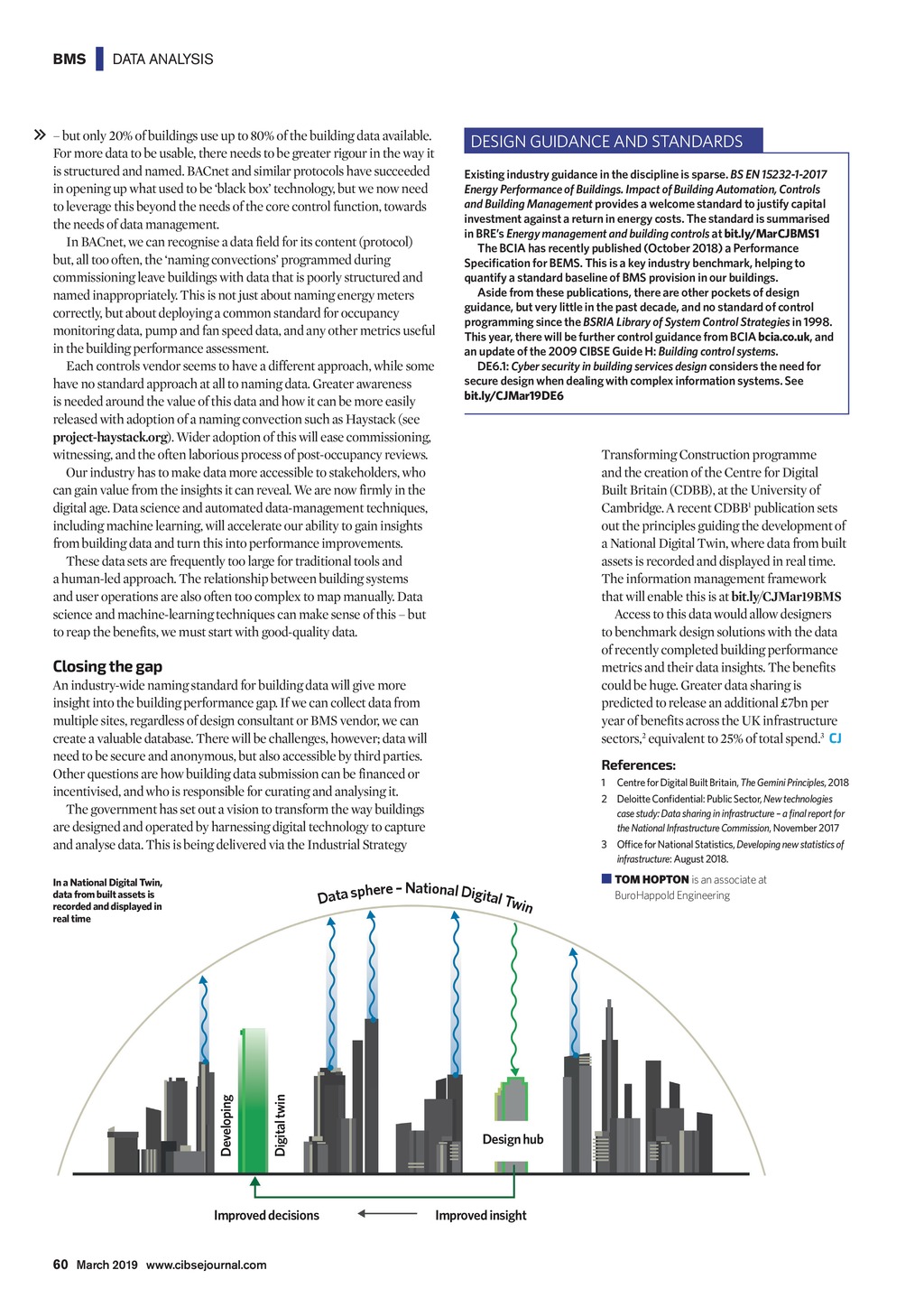




BMS | DATA ANALYSIS but only 20% of buildings use up to 80% of the building data available. For more data to be usable, there needs to be greater rigour in the way it is structured and named. BACnet and similar protocols have succeeded in opening up what used to be black box technology, but we now need to leverage this beyond the needs of the core control function, towards the needs of data management. In BACnet, we can recognise a data field for its content (protocol) but, all too often, the naming convections programmed during commissioning leave buildings with data that is poorly structured and named inappropriately. This is not just about naming energy meters correctly, but about deploying a common standard for occupancy monitoring data, pump and fan speed data, and any other metrics useful in the building performance assessment. Each controls vendor seems to have a different approach, while some have no standard approach at all to naming data. Greater awareness is needed around the value of this data and how it can be more easily released with adoption of a naming convection such as Haystack (see project-haystack.org). Wider adoption of this will ease commissioning, witnessing, and the often laborious process of post-occupancy reviews. Our industry has to make data more accessible to stakeholders, who can gain value from the insights it can reveal. We are now firmly in the digital age. Data science and automated data-management techniques, including machine learning, will accelerate our ability to gain insights from building data and turn this into performance improvements. These data sets are frequently too large for traditional tools and a human-led approach. The relationship between building systems and user operations are also often too complex to map manually. Data science and machine-learning techniques can make sense of this but to reap the benefits, we must start with good-quality data. DESIGN GUIDANCE AND STANDARDS Existing industry guidance in the discipline is sparse. BS EN 15232-1-2017 Energy Performance of Buildings. Impact of Building Automation, Controls and Building Management provides a welcome standard to justify capital investment against a return in energy costs. The standard is summarised in BREs Energy management and building controls at bit.ly/MarCJBMS1 The BCIA has recently published (October 2018) a Performance Specification for BEMS. This is a key industry benchmark, helping to quantify a standard baseline of BMS provision in our buildings. Aside from these publications, there are other pockets of design guidance, but very little in the past decade, and no standard of control programming since the BSRIA Library of System Control Strategies in 1998. This year, there will be further control guidance from BCIA bcia.co.uk, and an update of the 2009 CIBSE Guide H: Building control systems. DE6.1: Cyber security in building services design considers the need for secure design when dealing with complex information systems. See bit.ly/CJMar19DE6 Transforming Construction programme and the creation of the Centre for Digital Built Britain (CDBB), at the University of Cambridge. A recent CDBB1 publication sets out the principles guiding the development of a National Digital Twin, where data from built assets is recorded and displayed in real time. The information management framework that will enable this is at bit.ly/CJMar19BMS Access to this data would allow designers to benchmark design solutions with the data of recently completed building performance metrics and their data insights. The benefits could be huge. Greater data sharing is predicted to release an additional 7bn per year of benefits across the UK infrastructure sectors,2 equivalent to 25% of total spend.3 CJ Closing the gap An industry-wide naming standard for building data will give more insight into the building performance gap. If we can collect data from multiple sites, regardless of design consultant or BMS vendor, we can create a valuable database. There will be challenges, however; data will need to be secure and anonymous, but also accessible by third parties. Other questions are how building data submission can be financed or incentivised, and who is responsible for curating and analysing it. The government has set out a vision to transform the way buildings are designed and operated by harnessing digital technology to capture and analyse data. This is being delivered via the Industrial Strategy In a National Digital Twin, data from built assets is recorded and displayed in real time References: 1 Centre for Digital Built Britain, The Gemini Principles, 2018 2 Deloitte Confidential: Public Sector, New technologies case study: Data sharing in infrastructure a final report for the National Infrastructure Commission, November 2017 3 Office for National Statistics, Developing new statistics of infrastructure: August 2018. Digital twin Developing here National Digita l Twi Data sp n Improved decisions TOM HOPTON is an associate at BuroHappoldEngineering Design hub Improved insight 60 March 2019 www.cibsejournal.com CIBSE Mar19 pp59-60 BMS Tom Hopton.indd 60 22/02/2019 18:23